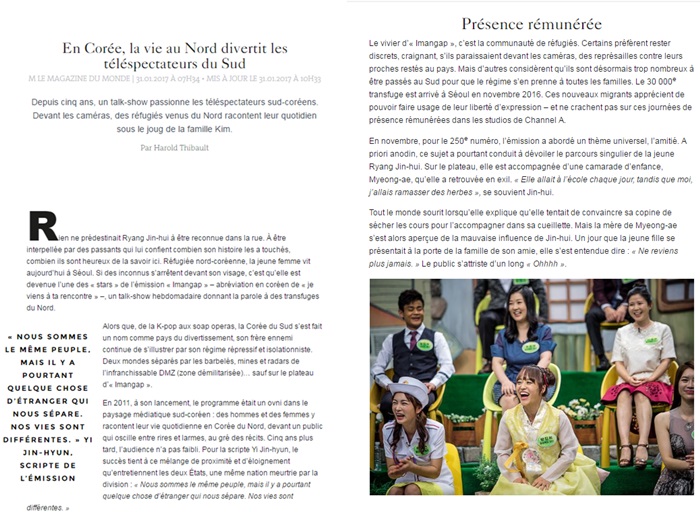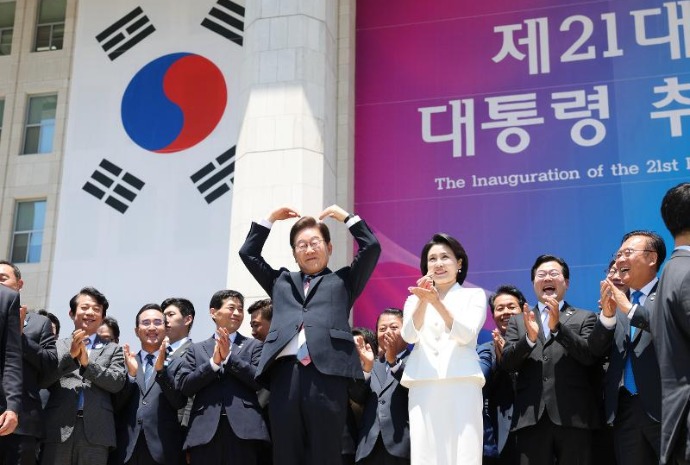
The magazine M, published by Le Monde, a French daily, features an article on Jan. 31 about Korean talk shows that feature former refugees from North Korea.
Korean talk shows that invite into the studio former refugees from North Korea to talk about their experiences have been attracting quite a lot of media attention overseas.
The magazine M, published by the French daily Le Monde, recently talked about two such shows: Channel A’s “Imangap,” a Korean abbreviation for “On My Way to Meet You Now" (이제 만나러 갑니다, 이만갑), and TV Chosun’s “Moranbong Club" (모란봉 클럽).” Both shows deal with the lives of former North Koreans, back when they were in the North, and their experiences on their way to the South.
“The two regions are separated by barbed wire, mines and radar at the impassable Demilitarized Zone... except for on stage at 'Imangap,'" the article said.
The article elaborated on the special characteristic of the shows, which deal with both entertainment and political issues, saying, “A panelist performs a dance from a K-pop group, but a few minutes later the whole audience bursts into tears when a woman is reunited with her family after several years of separation.” During the interview with Le Monde, the scriptwriter for "Imangap," Yi Jin-hyun, said “Its success is due to the mixture of proximity and distance between the two states.” The show, which launched in December 2011, is the longest running program on Channel A.
The article also talked about a similar program on TV Chosun, “Moranbong Club,” which began in 2014. It addresses various topics such as old soldiers explaining how to use gun artillery and the ban on dyed hair in North Korea.
The magazine said, “Some prefer to remain discreet, fearing that if they appear before the camera their relatives back home may be the target of reprisal… but they are now too numerous for the regime to track down all the families... The 30,000th defector arrived in Seoul in November 2016 and the migrants now appreciate being able to make use of their freedom of expression.”
The article mentioned the story of Ryang Jin-hui, one of the regular cast members on “Imangap.” In the mid-1990s, amid the most severe famine that has ever hit North Korea, her father tried to barter with Chinese to feed the family, but soon got arrested by the border guards. To get him released, her family had to use all they had, including the house, as a bribe. “We had nothing left. I was 7,” she said.
She was forced to abandon school to gather edible herbs from nearby mountains to feed the family. To get out of the misery, her mother decided to leave the country with her. They fled to China, where they were sold by traffickers to a Chinese peasant. After seven years of living in fear, they gained strength to run away to Laos, then Thailand and, finally, to Seoul in December 2013.
When she first came to South Korea, she had a hard time because she couldn't understand all the newly adopted words in modern Korean, which are never used in the North. However, she's now a TV personality who is sometimes even recognized by strangers in the street.
The article concluded by saying that many North Korean former refugees are having a hard time integrating into the “highly competitive society” of Korea. It also said that, “Because of the growing number -- with 1,400 arriving in 2016 alone -- they no longer get the sympathy like the ones that came before.”
By Kim Young Shin
Korea.net Staff Writer
Photo: Magazine M, published by Le Monde
ysk1111@korea.kr
